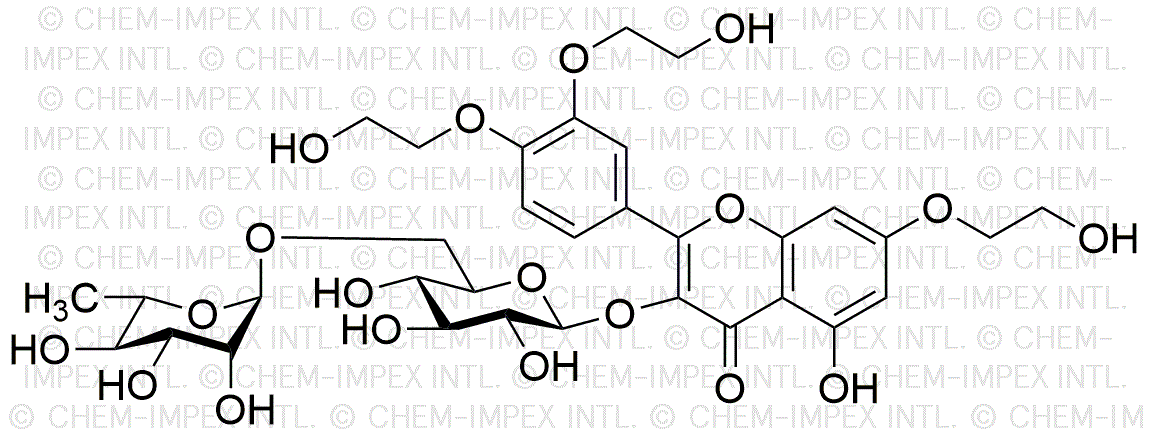Troxerutin is widely utilized in research focused on various practical applications across different industries:
- Pharmaceuticals: Troxerutin is commonly used in formulations aimed at improving venous circulation and reducing symptoms of chronic venous insufficiency. Its ability to strengthen capillary walls makes it a valuable ingredient in medications for vascular health.
- Cosmetics: Due to its antioxidant properties, troxerutin is incorporated into skincare products to protect the skin from oxidative stress, helping to reduce signs of aging and improve overall skin appearance.
- Food Industry: As a natural flavonoid, troxerutin is explored for its potential health benefits, including anti-inflammatory and antioxidant effects, making it a candidate for functional food products aimed at enhancing consumer health.
- Research Applications: In laboratory settings, troxerutin is used to study its effects on cellular processes, particularly in models of inflammation and oxidative stress, providing insights into its therapeutic potential.
- Veterinary Medicine: Troxerutin is also being researched for its applications in veterinary care, particularly in treatments aimed at improving circulation and reducing swelling in animals.
General Information
Properties
Safety and Regulations
Applications
Troxerutin is widely utilized in research focused on various practical applications across different industries:
- Pharmaceuticals: Troxerutin is commonly used in formulations aimed at improving venous circulation and reducing symptoms of chronic venous insufficiency. Its ability to strengthen capillary walls makes it a valuable ingredient in medications for vascular health.
- Cosmetics: Due to its antioxidant properties, troxerutin is incorporated into skincare products to protect the skin from oxidative stress, helping to reduce signs of aging and improve overall skin appearance.
- Food Industry: As a natural flavonoid, troxerutin is explored for its potential health benefits, including anti-inflammatory and antioxidant effects, making it a candidate for functional food products aimed at enhancing consumer health.
- Research Applications: In laboratory settings, troxerutin is used to study its effects on cellular processes, particularly in models of inflammation and oxidative stress, providing insights into its therapeutic potential.
- Veterinary Medicine: Troxerutin is also being researched for its applications in veterinary care, particularly in treatments aimed at improving circulation and reducing swelling in animals.
Documents
Safety Data Sheets (SDS)
The SDS provides comprehensive safety information on handling, storage, and disposal of the product.
Product Specification (PS)
The PS provides a comprehensive breakdown of the product’s properties, including chemical composition, physical state, purity, and storage requirements. It also details acceptable quality ranges and the product's intended applications.
Certificates of Analysis (COA)
Search for Certificates of Analysis (COA) by entering the products Lot Number. Lot and Batch Numbers can be found on a product’s label following the words ‘Lot’ or ‘Batch’.
Numéro de catalogue
Numéro de lot/série
Certificates Of Origin (COO)
This COO confirms the country where the product was manufactured, and also details the materials and components used in it and whether it is derived from natural, synthetic, or other specific sources. This certificate may be required for customs, trade, and regulatory compliance.
Numéro de catalogue
Numéro de lot/série
Safety Data Sheets (SDS)
The SDS provides comprehensive safety information on handling, storage, and disposal of the product.
DownloadProduct Specification (PS)
The PS provides a comprehensive breakdown of the product’s properties, including chemical composition, physical state, purity, and storage requirements. It also details acceptable quality ranges and the product's intended applications.
DownloadCertificates of Analysis (COA)
Search for Certificates of Analysis (COA) by entering the products Lot Number. Lot and Batch Numbers can be found on a product’s label following the words ‘Lot’ or ‘Batch’.
Numéro de catalogue
Numéro de lot/série
Certificates Of Origin (COO)
This COO confirms the country where the product was manufactured, and also details the materials and components used in it and whether it is derived from natural, synthetic, or other specific sources. This certificate may be required for customs, trade, and regulatory compliance.

